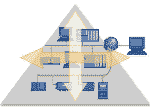 |
 |
From Fieldbus to Industrial Ethernet
By : Jim Pinto, Compared to traditional, non-Ethernet-based industrial solutions, Ethernet technology delivers substantially higher performance and several other advantages. Will there be more than one standard? When fieldbus was introduced two decades ago, the same question was being asked.
May 2013
|
 First developed almost two decades ago, many different fieldbus networks still continue to dominate industrial automation and process control. After prolonged prognostications (dubbed the "Fieldbus Wars"), several standards emerged, each focused on different market segments.
First developed almost two decades ago, many different fieldbus networks still continue to dominate industrial automation and process control. After prolonged prognostications (dubbed the "Fieldbus Wars"), several standards emerged, each focused on different market segments.
Flexibility was achieved through different types of field devices operating with dissimilar networks. Due to the very low quantities of components sold, overall costs remain high for both controls and field devices, and particularly for wiring. With more than 500 million ports installed worldwide in enterprise networks, Ethernet has become the dominant networking technology and a de facto standard. It delivers wide availability, openness, high performance and cost-effectiveness, and enjoys such wide acceptance because it is easy to understand, deploy, manage and maintain. Compared to traditional, non-Ethernet-based industrial solutions, Ethernet technology delivers substantially higher performance. And, because it is based on industry standards, it can run on and be connected to any Ethernet-compliant device from any vendor. However, standard Ethernet has the following disadvantages when it comes to industrial applications:
Bridging the differencesAutomation and control protocols differ significantly from standard Ethernet implementations. But major control system manufacturers now incorporate versions of Ethernet networks and higher-level Ethernet-related protocols in their product offerings.Today, "industrial Ethernet" is being promoted with several different proprietary designs. More than 20 different protocols compete in various segments of this rapidly growing market, each offering adaptations to meet different real-time and cost challenges. Here are some of the leaders:

|
 Pinto's Points How to win in the Automation Business Go shopping - books, electronics, CD/DVD Selected advertising coming here. Contact Jim Pinto for rates. |
Return to Index of all JimPinto Writings

 Return to JimPinto.com HomePage
Return to JimPinto.com HomePage
If you have ideas or suggestions to improve this site, contact: webmaster@jimpinto.com
Copyright 2006 : Jim Pinto, San Diego, CA, USA
